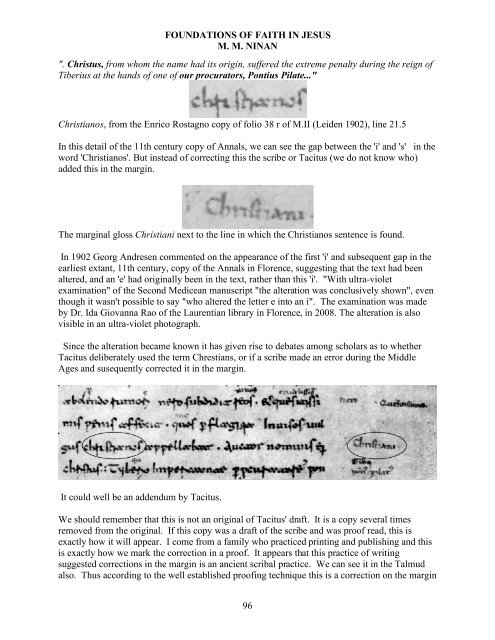Foundations of Faith
Create successful ePaper yourself
Turn your PDF publications into a flip-book with our unique Google optimized e-Paper software.
FOUNDATIONS OF FAITH IN JESUS<br />
M. M. NINAN<br />
". Christus, from whom the name had its origin, suffered the extreme penalty during the reign <strong>of</strong><br />
Tiberius at the hands <strong>of</strong> one <strong>of</strong> our procurators, Pontius Pilate..."<br />
Christianos, from the Enrico Rostagno copy <strong>of</strong> folio 38 r <strong>of</strong> M.II (Leiden 1902), line 21.5<br />
In this detail <strong>of</strong> the 11th century copy <strong>of</strong> Annals, we can see the gap between the 'i' and 's' in the<br />
word 'Christianos'. But instead <strong>of</strong> correcting this the scribe or Tacitus (we do not know who)<br />
added this in the margin.<br />
The marginal gloss Christiani next to the line in which the Christianos sentence is found.<br />
In 1902 Georg Andresen commented on the appearance <strong>of</strong> the first 'i' and subsequent gap in the<br />
earliest extant, 11th century, copy <strong>of</strong> the Annals in Florence, suggesting that the text had been<br />
altered, and an 'e' had originally been in the text, rather than this 'i'. "With ultra-violet<br />
examination" <strong>of</strong> the Second Medicean manuscript "the alteration was conclusively shown", even<br />
though it wasn't possible to say "who altered the letter e into an i". The examination was made<br />
by Dr. Ida Giovanna Rao <strong>of</strong> the Laurentian library in Florence, in 2008. The alteration is also<br />
visible in an ultra-violet photograph.<br />
Since the alteration became known it has given rise to debates among scholars as to whether<br />
Tacitus deliberately used the term Chrestians, or if a scribe made an error during the Middle<br />
Ages and susequently corrected it in the margin.<br />
It could well be an addendum by Tacitus.<br />
We should remember that this is not an original <strong>of</strong> Tacitus' draft. It is a copy several times<br />
removed from the original. If this copy was a draft <strong>of</strong> the scribe and was pro<strong>of</strong> read, this is<br />
exactly how it will appear. I come from a family who practiced printing and publishing and this<br />
is exactly how we mark the correction in a pro<strong>of</strong>. It appears that this practice <strong>of</strong> writing<br />
suggested corrections in the margin is an ancient scribal practice. We can see it in the Talmud<br />
also. Thus according to the well established pro<strong>of</strong>ing technique this is a correction on the margin<br />
96


















